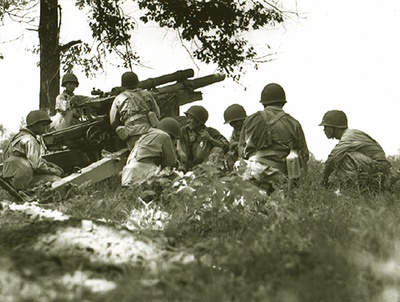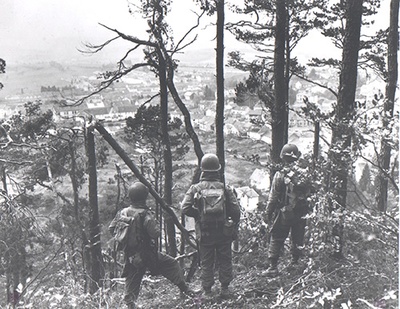“The best troops are called upon to do the hardest fighting. Whenever a general finds himself up against a tough proposition he sends for the best troops he has…A man who is being shot at daily has a hard time recognizing it as a compliment when, dead tired, bruised and battered, he is called upon to make one more effort to risk his life another time—but it is a compliment, nevertheless.”
—Colonel Sherwood Dixon, in a letter to 442d RCT Chaplain Masao Yamada, November 22, 1944
Sixty years ago, two major German supply lines ran to the western front in France. One was near Ardennes in northern France where the famous Battle of the Bulge was fought. The other was farther to the east through a pass in the Vosges Mountains where the small towns of Bruyères, Biffontaine, and Belmont lie. Since June of 1940, France had been occupied by the German Army. The occupation had been total and humiliating. Not until June of 1944, when the allies stormed the beaches of Normandy, did help arrive.
Aided by the French resistance and the largest amphibious assault in history, the allied armies began pushing back a tough and experienced German army. After four months, the allies found themselves in the Vosges region of eastern France and were given the task of capturing the little town of Bruyères and the surrounding region. One of the divisions assigned this task was the 36th Infantry Division from Texas and Oklahoma. Attached to the 36th was a group of soldiers consisting entirely of Japanese-American GIs. They were known as the 442nd/100th Regimental Combat Team.
About a third of the 442/100 was from the mainland United States, where they and their families were imprisoned in internment camps under the orders of a president and nation that distrusted their loyalty. The other third was from Hawaii where they suffered a discrimination of their own. As the war raged on, the Japanese-Americans were barred from joining the army. A year of brutal fighting passed before the nation realized that the participation of every American would be crucial for victory. The laws were changed to allow the Japanese-Americans to fight, and a special unit called the 442nd Regimental Combat Team was created for Japanese-American volunteers. They joined the existing 100th Infantry Battalion consisting of Japanese-Americans who had been in the Army before the war began. It was this unit that helped liberate the Vosges Mountains from the German Army.
When fighting around Bruyères started on September 30, 1944, the Germans had had four years to dig in and prepare for the ally’s counterattack. They were battle-toughened and had superior weaponry. Holding the area was of utmost importance to them as the Vosges were at the doorstep of the German homeland. It took 19 days of savage fighting to liberate the town. But without also controlling the surrounding mountains, the area would not be secured from further attack. After liberating Bruyères, the soldiers were told to take the village of Biffontaine and the mountains.
These mountains were heavily forested, very cold and muddy in October, and in some places particularly steep. The Germans held the high ground on every battlefield and allies’ task was to take on the German army hill by hill. Each night the men found themselves trying to sleep in puddle-filled fox holes with the rain, or sometimes snow, coming down on them in the pitch-black forest. During the day, a heavy fog would often drop into the mountains.
“Sometimes you couldn’t see 25 feet in front of you,” said one soldier. “So you had to be careful of what you shot at. You looked at the helmet and if it wasn’t one of yours you’d shoot. Night was even worse. You couldn’t even see your hands, but you could hear the Germans talking in the dark. And probably they us. One time I even heard the Texans.”
During this battle, a battalion of Texans from the 36th Division penetrated too deep behind enemy lines. They were quickly surrounded by the Germans and cut off from the main army. Though they were running low on food, ammo and men, they refused to surrender. They became known as the Lost Battalion.
As word of their plight reached the home front, rescuing the Lost Battalion suddenly became very important. General John Dahlquist ordered one of this best teams to do it—the 442/100th.
The team engaged in relentless fighting in brutal conditions. In addition to hidden machine gun nests, the powerful German 88 artillery gun would fire into the surrounding tree tops; deadly shrapnel rained on the ground. After six days of the most vicious fighting of the war, the 442/100th charged up the mountain to rescue the Lost Battalion. There were 275 men in the Lost Battalion when the encirclement occurred; 211 were ultimately rescued. Even after the rescue, the 442nd/100th were told to continue pushing the Germans back for another nine days. At the start of the Vosges campaign, there were 2,943 men in the 442nd/100th. By the end of the campaign 161 had died, 43 were missing, and more than 800 were seriously wounded.
On October 21, 2004, I waited in the San Francisco International Airport, looking for the 52 other members of the tour that would revisit the scenes of the 442nd/100th’s victories. I had signed on for this trip to meet a few of the men who made the life I enjoy possible. I can credit much of my good fortune to opportunity, hard work and education, but also the legacy and achievements of the Japanese-American men and women of the World War II era. They had endured the internment camps with strength and dignity, served in the armed forces, despite the lingering bigotry that lies in the heart of all too many, proved the mettle that is at the core of Japanese-American culture.
I put on the red, white and blue “Bruyères, France” baseball cap provided by Lawson Sakai and Ed Nelson, organizers and leaders of the trip. Sure enough, I quickly met up two others from Portland, Oregon. All told, our group included seven veterans: Ted Fujimoto, Roy Fujiwara, Jimmie Kanaya, Ted Oye, Lawson Sakai, Willie Tanamachi and Mike Tsuji, joined by widows of veterans, friends, family, and people (including myself) just interested in the Lost Battalion’s story. We were later joined on the trip by veterans Shinkichi Tajiri and Ted Wakai and their families.
When our plane touched down in Strasbourg, France, we were met by a three-member crew from Nippon TV. They would be our companions for the next three days as they interviewed the veterans and filmed the trip. The entire celebration had to be an unusual experience for the Japanese-Americans who tend toward modesty and humility. But the fact is that they, the veterans, and we, friends and family, were honored and celebrated by the French to a degree what was entirely unexpected.
From the airport we boarded onto a big purple/pink bus manned by Thomas, our affable and unconsciously daring German bus driver. There was no unpaved mountain road too winding or treacherous, no cobbled street too narrow, that Thomas would not drive. He once wedged the bus into a space so tight that he could move neither forward nor backward without smashing the tiny French cars parked around him. By the time he explained the situation to our tour organizer, Lawson Sakai, angry trapped French motorists were honking and getting out of their cars. Immediately, the ex-squadron leader ordered all men out of the bus to lift and move the parked car that happened to be in the way. Once he witnessed this feat, Thomas added this weapon to his driving quiver and we found ourselves lifting cars whenever he felt the need for “more space.”
After a sleepy breakfast the next morning, we began the long drive to the little city of Brouvelieures in the Vosges area of Northern France. After three hours, the bus turned into city streets surprisingly empty for a Saturday, but around a corner the street widened and there, in front of the town hall, was what looked like the town’s entire population. About 200 men, women and children turned as one, waving French and American flags and applauding our arrival. Thomas gently eased the bus alongside the crowd, and, because no one wanted to go out first, and because seven of our guys had already taken the city by storm 60 years ago, and because it seemed the right thing to do, we sent out our 80-year-old veterans. They were warmly welcomed by the citizens, the town mayor and other dignitaries. The children seemed especially interested in getting their pictures taken with these old war heroes. This was a scene to be repeated over the next couple of days.
We were quickly hustled into a hall which had been transformed into a World War II museum containing the uniforms and weaponry used during the battle as well as articles and photos relating to the liberation. The museum was packed with townspeople and we were shocked at the incredible reception we received.
After a short visit, we were driven up into the mountains to the first of three war monuments we would see over the next two days. While the larger more prominent monuments are erected in town squares, more modest monuments are placed where the actual battles took place, usually in the thickly forested mountains. This particular monument was for the 45th Infantry Division, which did a lot of the fighting in the area. As the bus pulled to a stop, we saw that the townspeople had preceded us and were waiting. After a prayer and invocation, our veterans and then the French veterans placed wreaths before the monument. Lawson Sakai also lit some incense, a Buddhist tradition that was to be repeated throughout the weekend.
Afterward about 200 of us packed into a cozy hall in the town of Belmont for a lunch of country ham, French Brie, apple strudel and, of course, French wine. The Mayor stood and thanked all the veterans for coming now and for coming 60 years ago to save the town. What happened next was overwhelming. A group of men dressed in green WWII army fatigues and boots stepped up to the stage and sang an old soldier’s song about fighting and coming home to one’s honey. It was sweet and moving. They followed this with “God Bless America.” I’ve never been particularly patriotic, but at that moment I was truly proud to be an American.
After lunch, we were loaded into a caravan of WW II-era jeep willies and troop carriers. The ride on a 60-year-old army jeep is surprisingly smooth, and as our curious caravan made its way through the streets and countryside we were met by smiles and waves. The jeeps wound their way over dirt roads to a mountain clearing where the battle for the Lost Battalion was fought, and which contained a monument for the 36th Infantry battalion.
The crowd that met us included younger and older French veterans in their uniforms. Monique Carlesso was ten years old when the Americans swept in to liberate the town. Her husband, Serge, who had passed away some years ago, lost his leg during the Battle for Bruyères and was treated by the American forces. Here we were honored to be joined by Captain John Halleran who served with the 36th Division, 141st Infantry Regiment, Company I from 1941 to 1945, and his family.
After the ceremony we were shuttled back to Biffontaine for a reception. Wine and cheese flowed freely and we were all simultaneously relaxed, exhausted, and energized. One of the veterans, Roy Fujiwara from Seattle, was regaling a group of French and Americans about a particular battle in Italy. I have never heard anyone so cheerfully describe getting shot in the face. In another group, a French family was trying to locate Nelson Akagi, a veteran from Utah who visited 10 years ago. They wanted to give him a special book they had purchased for him. When they were told he had not made the trip, they gave us the book and asked that we get it to him and his family. Such was the thanks and gratefulness of the villagers.
The next morning we awoke for an early bus ride to Bruyères, where we attended mass at the town church. Mike Tsuji wistfully pointed to a house across the street that he and his company had slept in and dried their clothes over night 60 years ago. “But the next morning,” he added dolefully, “we got all wet because of the rain.”
After the service, we marched in a veteran’s parade that finished with another ceremony at a French war memorial in the town square. We were again shuttled up into the mountains with our ever-present jeeps and “American GIs.” This was the final and largest memorial service at the Monument of Biffontaine for the 100/442 RCT. The 400 in attendance included a large number of French veterans, a team of about 20 members of the French National Guard standing at attention with their carbines, and a US Army color guard.
An American helmet was placed on the monument, floral wreaths and incense before it. A choir sang the Star Spangled Banner, and the band played the French national anthem. We were shuttled back down into town for a final reception and lunch. Among the many speeches of friendship, two comments stood out. One was made by a French dignitary who asked the families and children of the next generation “to call him and to never stop coming to France. We know what you have done for us.”
The other comment was one made by Lawson Sakai: “In the heat of battle for the liberation of Bruyères, one of the ladies of this town brought one of our wounded guys into her home and held him until he took his last breath. These are the people we are with, and who will always be our friends.”
That evening, the sunset glowed orange over the several thousand marble crosses and stars of David at the Quequement American Military Cemetery in Épinal, where we held a quiet memorial service for the uncle of one of the travelers. The nephew was racked with sobs as he stood before the cross. He later told me that the decision to leave his uncle’s remains in France rather than bring him back home to the states was a controversy in his family. In the Buddhist tradition, it’s important for the remains to be kept with other ancestors in order for the family to give proper and enduring honor.
With the help of the cemetery superintendent Tom Cavaness, we located several other 442nd men and lit incense at their crosses. I asked Lawson if a soldier could be buried under a Buddhist wheel or Muslim Crescent. “There weren’t a lot of Buddhists or Muslims in those days,” he said. “I think you only got a cross or a star.”
The next day, Monday, we returned to the 442nd/100th monument in the mountains. We strolled in woods once the site hellish battles, now green and peaceful and beautiful. A short distance away, we took pictures of Shinkichi Tajiri and the memorial sculpture he donated to the city of Bruyères a number of years ago. Tajiri was in the 442nd and is now a renowned artist in The Netherlands.
On the plane ride home, I could not stop thinking of these white-haired men. Their step, though slowed, was without hesitation; certain in the way men walk when they have marched, crawled, and fought, leaving behind their blood and the bodies of their friends for a purpose larger than themselves. For a short weekend, these old soldiers were made young again, lifted up by the power of honor and remembrance from the children of a gracious country.
Soon they will no longer be able to make this trip, and only a few stone monuments and the whispered cries of their comrades in the Vosges forest will bear lasting witness. But for now, these old lions know what they accomplished, and their spirit will be carried forward by the people on that bus, by their children, by America itself.
*This article was originally published in Nikkei Heritage Vol. XVII, no.1 (Spring 2005), a journal of the National Japanese American Historical Society.
© 2005 National Japanese American Historical Society






